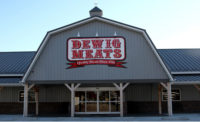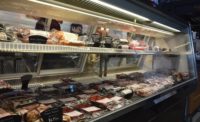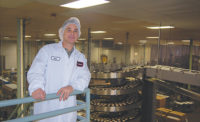The history of S. Wallace Edwards & Sons doesn’t go back quite as far, but it has played an important role in maintaining the tradition of Virginia country hams. The company, stretching back three generations, has been producing top-quality hams, as well as bacon and sausages, since 1926. S. Wallace Edwards was originally a ferryboat captain working for his father-in-law. To make some extra money, he began selling ham sandwiches to his passengers, using ham that he had cured on his farm. The demand for the ham became great enough that he was able to quit his day job and become a full-time meat processor.
At the onset, Edwards & Sons was a direct-to-consumer business, and by the 1940’s slaughtered up to 250 hogs a day. The company got out of the slaughtering business in the 1960s, and now under the leadership of president and curemaster Samuel Edwards III, it has expanded into a successful mail-order business and caters to specialty food stores and white-tablecloth restaurants nationwide.
“When I came into the business, we opened two of our own ham shops and expanded the catalog business,” he says. “Today we sell all over the United States.”
Edwards says that the company made a decision to stay away from major grocery chains, though it does sell to some smaller, independent/upscale grocery stores. It also has a country store on the property.
“There are tons of people in that business,” he explains, “and you can lose the business over a penny. We decided to focus on the outstanding and stay away from the commodity market, because in my opinion, that’s been the demise of a lot of country ham producers in this country. We’ve shot ourselves in the foot by seeing who can produce a country ham the cheapest, and whoever sells it for the lowest wins the sale. Unfortunately, this has caused the demise of many country ham producers. Low or no profits and poorer quality is not the way to survive in the meat business.”
By focusing on quality product and service, Edwards & Sons has grown both its wholesale and retail consumer side of the business. The company’s hams and other products have garnered write-ups in magazines including Bon Appétit and Martha Swewart’s Living, and they are sold to white-tablecloth restaurants across the country. Those types of placements, Edwards says, help the company gain customers who are still willing to pay for upper-end foods.
“The Martha Stewarts of the world, their focus is on really unique things — not foods that companies make millions of pounds of,” he says. “It introduces to the public what they’re trying to get across, that this is something really special, and there’s usually only a small amount of it made.”
A Virginia tradition
A traditional Virginia country ham is dry-cured and has had a chance to age for 4 to 14 months depending on the type of country ham. While modern technology, including coolers and humidity-controlled smokehouses, has made the process easier, Edwards & Sons still uses the same curing methods that pre-date electricity by duplicating winter, spring summer and fall in the curing/aging process.
The cure, which was perfected by Edwards’ grandfather more than 85 years ago, is hand-rubbed onto the hams, which are left to cure for approximately 30 days (winter). After that time, equalized for 2-3 weeks (spring) and then smoked for a full week over hickory wood and sent to one of the company’s aging rooms (summer). There, they are aged under climate-controlled conditions for the required time. The company’s cured hams include a 3-month, 6-month, 12-month and 20-month variety, with the flavor becoming more intense as the meat ages. Edwards adds that the cured hams are ideal for mail order, because they are extremely shelf stable.
One of the company’s more recent products, a thin-cut, prosciutto-style ham, is its entry into a certified-humane, antibiotic free, pasture-raised, breed-specific pork — Berkshire to be exact. Edwards notes that for a ham to successfully age for 12 to 14 months, it needs to be well-marbled, like the Berkshire pork.
The Berkshire hams that Edwards produces, like the famed Serrano hams of Spain, are not meant to be cooked or fried. He was explaining to a New York chef the concept of these American country hams and how they should be prepared like prosciutto, Edwards jokingly called them “Surryano” hams, as a tribute to the company’s home of Surry, Va.
“He took it and put it on his menu like that,” Edwards says. Since the restaurant’s menu is watched by other restaurants in New York City, the buzz about the ham began to build, and the name stuck. The hams are available in boneless and bone-in varieties, as well as slices and tips. The company also has expanded into Berkshire bacon and sausage as well.
While sales of the Surryano hams represent just about 10 percent of the company’s overall sales, it has become a successful new niche. A 7- to 9-pound boneless Surryano ham sells for approximately $180, which is still considerably cheaper than an imported Serrano ham.
Along with its upper-end hams, Edwards & Sons has a diversified product line. Bacon and sausage make up about half of the company’s sales, and its ham products also include a pumped “city ham,” along with its dry-cured country hams.
“It’s definitely a growing niche for us,” Edwards says of the city hams, “but there are a whole lot of people who make those.” Along with the increased competition, Edwards acknowledges his own preference toward the dry-cured products.
“I don’t know if I’ve got a ham snob problem, but why would you eat [a commodity ham] when you could have this artisan dry-cured product that’s got so much more flavor to it,” he says.
Ensuring a healthy future
Edwards & Sons has expanded continuously since its start and now has 50,000 square feet of operating and office space. The largest expansion came in 1997, when Edwards added a large, partially empty building, so that when the company needed to add another cooler or a processing room, it would build a room inside the shell.
“We were building something every five to seven years, and I felt like we were in the construction business,” Edwards said. As a result, expansions are able to get up and running in a matter of weeks instead of months.
Edwards & Sons has operated through the Great Depression, as well as numerous economic upturns and downturns since. Edwards recalls interest rates of 21 percent when he first got into the business after college. Nevertheless, each generation of ownership has maintained the business well and kept it growing and adjusting to the current times. Edwards’ father took over the business in the 1950s and helped shift it from slaughter to processing, while he has positioned it as a maker of upper-end, gourmet products.
Edwards notes that his own start in the business began with splitting hickory logs, making sausage patties by hand and cleaning out the grease pit. While it wasn’t glamorous work, he says that the experience has been invaluable.
“I understand completely the process, and when they run into a problem, quite often I can solve it pretty quickly,” he says. “My son is amazed that I still know/remember “the trivial stuff” like where the breaker switch is in the electrical room for the receptacles in the sausage kitchen or what refrigeration compressors are supposed to sound like when they are running.”
Edwards moved into the office when he graduated from college, and his father gave him the opportunity to see all the facets of the business. That experience, he says, helped him understand the futility of trying to compete in the retail commodity market. He tried to focus on supermarket sales when he first got out of college, and he managed to grow the company’s sales by 30 percent the first year.
“I was actively going out and getting new restaurant business and new grocery business, and at the end of the year we looked at the bottom line, and I said, ‘We didn’t make any more money than we did the previous year selling 30% less tonnage,’” he recalls. “If you’re selling dry cured hams, bacon and sausage against the same type products filled with water, you’re going to lose all day long. It took me a year to figure that out.”
Edwards has a son and a daughter who are both out of college and deciding whether or not to get into the family business.
“I told them they need to go somewhere else and work for three to five years in whatever field they want, and we’ll talk about it then,” he says. “If they decide to come back, then great. If they don’t, great. The business has changed and will continue to change and I think they both have a lot of talents they can bring to the table.”
Edwards notes that being a small business owner, he’s had to wear many hats.
“Wearing all of these hats you get it in mind that it’s all about yourself,” he says.
However, Edwards says, now the company has a number of talented individuals on board with some that have worked here for over 20 years. For example, after searching for the right sales manager for years, he found someone who has been able to grow sales at a faster pace than the company has seen in the last 15 years, and in a weakened economy.
“I feel comfortable now that if something happened to me, even without a current family member in this seat, that the company would still run successfully because we’ve got enough great people on board.”











